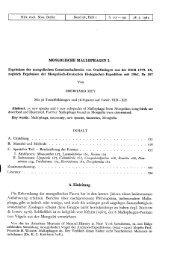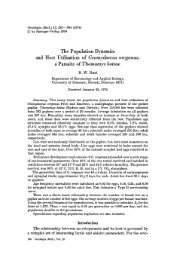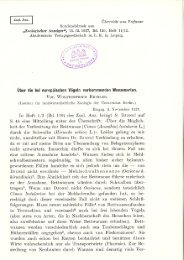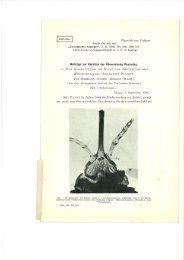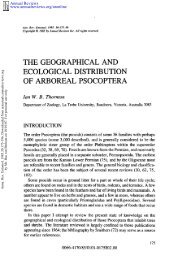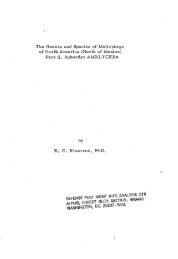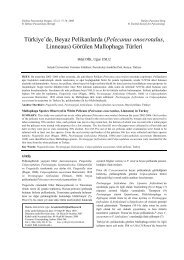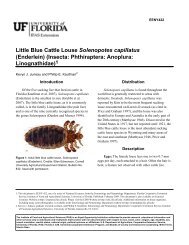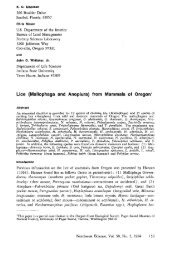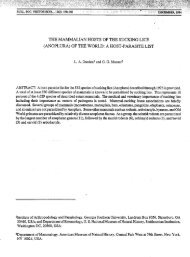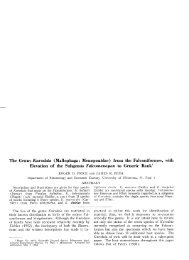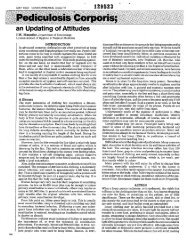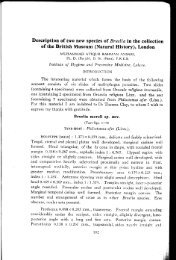Phthiraptera (Amblycera and Anoplura) parasites of the Family ...
Phthiraptera (Amblycera and Anoplura) parasites of the Family ...
Phthiraptera (Amblycera and Anoplura) parasites of the Family ...
Create successful ePaper yourself
Turn your PDF publications into a flip-book with our unique Google optimized e-Paper software.
Rudolstädter nat.hist. Schr. 13, 115-118 Rudolstädter nat.hist. Schr. 13 (2005) Dezember 2005 115<br />
<strong>Phthiraptera</strong> (<strong>Amblycera</strong> <strong>and</strong> <strong>Anoplura</strong>) <strong>parasites</strong> <strong>of</strong> <strong>the</strong> <strong>Family</strong> Octodontidae,<br />
Ctenomyidae <strong>and</strong> Abrocomidae (Mammalia: Rodentia) from Chile<br />
LUCILA MORENO SALAS 1 , DOLORES DEL C. CASTRO 2 , JUAN C. TORRES-MURA 3<br />
<strong>and</strong> DANIEL GONZÁLEZ-ACUÑA 1<br />
Resumen<br />
<strong>Phthiraptera</strong> (<strong>Amblycera</strong> y <strong>Anoplura</strong>) parasitos de la Familia Octodontidae, Ctenomyidae y<br />
Abrocomidae (Mammalia, Rodentia) de Chile<br />
Ocho especies de piojos (Insecta: <strong>Amblycera</strong> & <strong>Anoplura</strong>) son reportados en nueve especies de roedores pertenecientes<br />
a las familas Octodontidae, Ctenomyidae y Abrocomidae. Ellos son Gyropus distinctus (<strong>Amblycera</strong>, Gyropidae) y<br />
Ferrisella chilensis (<strong>Anoplura</strong>, Hoplopleuridae) colectados desde Octodon degus; G. distinctus colectado de Octodon<br />
lunatus; Gyropus elongatus colectado de Aconaemys fuscus; Ferrisella disgrega colectado de Octodontomys gliroides;<br />
Ph<strong>the</strong>iropoios pearsoni (<strong>Amblycera</strong>, Gyropidae) colectado de Abrocoma bennetti; Ph<strong>the</strong>iropoios pollicaris colectado<br />
de Ctenomys magellanicus; Ph<strong>the</strong>iropoios nematophallus colectado de Ctenomys opimus y Gyropus parvus colectado<br />
de Ctenomys maulinus. Los piojos chupadores Ferrisella disgrega, Ph<strong>the</strong>iropoios pearsoni y Ph<strong>the</strong>iropoios<br />
nematophallus son reportados en Chile por primera vez. Reportamos Octodontomys degus como nuevo hospeador<br />
para Ferrisella chilensis, Abrocoma benetti para Ph<strong>the</strong>iropoios pearsoni, Ctenomys maulinus para Gyropus parvus,<br />
y Abrocoma bennetti para Ph<strong>the</strong>iropoios pearsoni.<br />
Zusammenfassung<br />
<strong>Phthiraptera</strong> (<strong>Amblycera</strong> und <strong>Anoplura</strong>) aus den Nagerfamilien Octodontidae, Ctenomyidae und<br />
Abrocomidae (Mammalia, Rodentia) von Chile<br />
Acht Arten von Tierläusen (<strong>Amblycera</strong> und <strong>Anoplura</strong>) wurden auf neun Nagetier-Arten der Familien Octodontidae,<br />
Ctenomyidae und Abrocomidae nachgewiesen. Dies sind: Gyropus distinctus (<strong>Amblycera</strong>, Gyropidae) und Ferrisella<br />
chilensis (<strong>Anoplura</strong>, Hoplopleuridae) ex Octodon degus; Gyropus distinctus ex Octodon lunatus; Gyropus elongatus<br />
ex Aconaemys fuscus; Ferrisella disgrega ex Octodontomys gliroides, Ph<strong>the</strong>iropoios pearsoni ex Abrocoma bennetti,<br />
Ph<strong>the</strong>iropoios pollicaris ex Ctenomys magellanicus, Ph<strong>the</strong>iropoios nematophallus ex Ctenomys opimus und Gyropus<br />
parvus ex Ctenomys maulinus. Ferrisella disgrega, Ph<strong>the</strong>iropoios pearsoni und Ph<strong>the</strong>iropoios nematophallus wurden<br />
zum ersten Mal in Chile festgestellt. Vier bisher unbekannte Wirt-Parasit-Beziehungen sind nachgewiesen worden,<br />
und zwar Octodontomys degus als neuer Wirt von Ferrisella chilensis, das gleiche Abrocoma benetti von P.<br />
pearsoni, Ctenomys maulinus von Gyropus parvus und Abrocoma bennetti von Ph<strong>the</strong>iropoios pearsoni.<br />
Summary<br />
Eight species <strong>of</strong> animal lice (Insecta: <strong>Phthiraptera</strong>) are reported from nine species <strong>of</strong> rodents belonging to <strong>the</strong><br />
families Octodontidae, Ctenomyidae <strong>and</strong> Abrocomidae. They are Gyropus distinctus (<strong>Amblycera</strong>, Gyropidae) <strong>and</strong><br />
Ferrisella chilensis (<strong>Anoplura</strong>, Hoplopleuridae) <strong>of</strong>f Octodon degus; Gyropus distinctus <strong>of</strong>f Octodon lunatus; Gyropus<br />
elongatus collected from Aconaemys fuscus; Ferrisella disgrega collected from Octodontomys gliroides; Ph<strong>the</strong>iropoios<br />
pearsoni (<strong>Amblycera</strong>, Gyropidae) collected from Abrocoma bennetti; Ph<strong>the</strong>iropoios pollicaris collected from Ctenomys<br />
magellanicus; Ph<strong>the</strong>iropoios nematophallus collected from Ctenomys opimus <strong>and</strong> Gyropus parvus collected from<br />
Ctenomys maulinus. The lice Ferrisella disgrega, Ph<strong>the</strong>iropoios pearsoni <strong>and</strong> Ph<strong>the</strong>iropoios nematophallus are<br />
reported from Chile for <strong>the</strong> first time. We report Octodontomys degus as a new host for Ferrisella chilensis,<br />
Abrocoma benetti for Ph<strong>the</strong>iropoios pearsoni, Ctenomys maulinus for Gyropus parvus, <strong>and</strong> Abrocoma bennetti for<br />
Ph<strong>the</strong>iropoios pearsoni.<br />
Keywords: <strong>Phthiraptera</strong>, sucking lice, chewing lice, new records, Rodents, Octodontidae, Ctenomyidae, Abrocomidae,<br />
Chile.<br />
1 L. Moreno Salas <strong>and</strong> Dr. D. González-Acuña, Facultad de Medicina Veterinaria, Universidad de Concepción,<br />
Casilla 537, Chillán, Chile.<br />
2 Dr. D. del C. Castro, Facultad de Ciencias Naturales y Museo de la Plata, Paseo del Bosque s/n, 1900, La Plata,<br />
Buenos Aires, Argentina.<br />
3 Dr. J. C. Torres-Mura, Museo Nacional de Historia Natural, Casilla 787, Santiago, Chile.
116<br />
Introduction<br />
The South American mammalian fauna contains<br />
an ancient (Oligocene) <strong>and</strong> diverse lineage <strong>of</strong><br />
Caviomorph rodents. They have distinctive characters<br />
such as <strong>the</strong>ir dental formula (1/1, 0/0, 1/1,<br />
3/3), small litter size, long gestation period, <strong>and</strong><br />
precociality; <strong>the</strong>y are also herbivores <strong>and</strong> live<br />
mainly in burrows (WOODS 1982, REDFORD &<br />
EISENBERG 1992). The family Octodontidae ranges<br />
in weight from 100 to 300 g, has a simplified<br />
occlusal pattern in <strong>the</strong> shape <strong>of</strong> an 8, <strong>and</strong> is<br />
distributed from southwestern Peru to sou<strong>the</strong>rn<br />
Chile <strong>and</strong> Argentina. It includes desert adapted<br />
rodents <strong>and</strong> also fossorial <strong>and</strong> semifossorial species<br />
(CONTRERAS et al. 1987). The Abrocomidae<br />
is a monotypic family (genus Abrocoma) whose<br />
species range from 200 to 300 g, <strong>and</strong> is found<br />
from Peru to central Chile <strong>and</strong> Argentina. These<br />
species have s<strong>of</strong>t fur, short limbs, <strong>and</strong> large ears<br />
<strong>and</strong> tails (REDFORD & EISENBERG 1992; SPOTORNO<br />
& WALKER 2000). The diverse family Ctenomyidae<br />
includes <strong>the</strong> single genus Ctenomys,<br />
adapted for a fossorial life, with a very short tail,<br />
small eyes <strong>and</strong> ears, <strong>and</strong> very long front claws.<br />
Ctenomys is distributed from sou<strong>the</strong>rn Peru <strong>and</strong><br />
Brazil to Tierra del Fuego (CONTRERAS et al. 1987,<br />
REDFORD & EISENBERG 1992).<br />
Parasites from <strong>the</strong> order <strong>Phthiraptera</strong> are poorly<br />
studied in Chile. For <strong>the</strong> Octodontidae <strong>the</strong>re are<br />
reports <strong>of</strong> Gyropus parvus WERNECK, 1936 in<br />
Octodon degus MOLINA, 1782 (WERNECK 1951);<br />
G. elongatus CASTRO, CICCHINO & TORRES-MURA,<br />
1987 in Aconaemys fuscus WATERHOUSE, 1842<br />
(CASTRO et al. 1987), <strong>and</strong> G. distinctus CASTRO &<br />
CICCHINO, 2002 in O. degus <strong>and</strong> O. lunatus OS-<br />
GOOD, 1943 (CASTRO & CICCHINO 2002). For <strong>the</strong><br />
family Ctenomyidae, WERNECK (1948) reported<br />
Ph<strong>the</strong>iropoios pollicaris EWING, 1924 in Ctenomys<br />
magellanicus BENNET, 1836 <strong>and</strong> CASTRO et al.<br />
(1987) reported G. p. parvus in C. magellanicus.<br />
For <strong>the</strong> family Abrocomidae, WERNECK (1948)<br />
reported Gyropus longus NEUMANN, 1912 in<br />
Abrocoma bennetti WATERHOUSE, 1837 <strong>and</strong> PRICE<br />
& TIMM (2000) reported Abrocomophaga<br />
chilensis EMERSON & PRICE, 1976 for <strong>the</strong> same<br />
host.<br />
Materials <strong>and</strong> methods<br />
L Moreno Salas et al.: <strong>Phthiraptera</strong> <strong>parasites</strong> <strong>of</strong> rodents from Chile<br />
All rodent specimens analyzed were from <strong>the</strong> collections<br />
<strong>of</strong> <strong>the</strong> National Museum <strong>of</strong> Natural History in Santiago,<br />
Chile. The lice were collected from <strong>the</strong> following species:<br />
51 specimens <strong>of</strong> Octodon degus, distributed from Huasco<br />
(28° 28’ S; 71° 13’ W) to Santiago (33º 27’ S; 70º 38’<br />
W), three Octodon lunatus from National Park Fray<br />
Jorge (30° 39’ S; 71° 40’ W) <strong>and</strong> Peñuelas National<br />
Reserve (33° 09’ S; 71° 32’ W), 19 Aconaemys fuscus<br />
distributed from Baños del Flaco (35° 57’ S; 70° 26’ W)<br />
to Vilches National Reserve, nine Aconaemys sagei from<br />
Malleco Lagoon (38° 12’ S; 71° 50’ W) <strong>and</strong> Paso Reigolil<br />
(39º 07’S; 71º 25’ W), 15 Octodontomys gliroides<br />
distributed from Zapahuira (18° 20’ S; 69° 36’ W) <strong>and</strong><br />
Chuzmiza (19° 41’ S; 69° 11’ W). For <strong>the</strong> family<br />
Ctenomyidae, <strong>the</strong>re were five Ctenomys maulinus from<br />
Maule Lake (36° 04’ S; 70° 30’ W), four Ctenomys<br />
magellanicus from Tierra del Fuego (54° 04’ S; 68° 57’<br />
W), <strong>and</strong> three Ctenomys opimus from Japu Bajo (18°<br />
24’ S; 69° 16’ W). For <strong>the</strong> family Abrocomidae, 13<br />
specimens <strong>of</strong> Abrocoma bennetti distributed from Huasco<br />
to Itata River (36° 50’ S; 72° 24’ W) were examined.<br />
The recovered <strong>Phthiraptera</strong> were stored in alcohol, <strong>and</strong><br />
for better identification <strong>the</strong>y were later mounted<br />
according to PALMA (1978). The lice are deposited in<br />
<strong>the</strong> collection <strong>of</strong> <strong>the</strong> Laboratory <strong>of</strong> Zoology, Faculty <strong>of</strong><br />
Veterinary Medicine, University <strong>of</strong> Concepción, Chillán,<br />
Chile. The material was collected by LUCILA MORENO<br />
SALAS <strong>and</strong> DANIEL GONZÁLEZ-ACUÑA.<br />
Results<br />
Suborder <strong>Amblycera</strong><br />
<strong>Family</strong> Gyropidae<br />
Genus Gyropus NITZSCH, 1818<br />
Gyropus elongatus CASTRO, CICCHINO & TORRES<br />
MURA, 1987<br />
Type host: Aconaemys fuscus WATERHOUSE, 1842<br />
O<strong>the</strong>r host: Aconaemys sagei PEARSON, 1984<br />
(CASTRO et al. 1987)<br />
Examined: 19 Aconaemys fuscus, positive to lice<br />
six, from El Flaco Hot Springs, Las Cabras (34º<br />
38’ S; 70º 41’ W) <strong>and</strong> Vilches National Reserve.<br />
Nine Aconaemys sagei, positive to lice three, from<br />
Malleco Lagoon <strong>and</strong> Paso Reigolil.<br />
Material examined: three males, three females,<br />
three larvae (nymphs).<br />
Gyropus distinctus CASTRO & CICCHINO, 2002<br />
Type host: Octodon degus (MOLINA, 1782)<br />
O<strong>the</strong>r hosts: Octodon lunatus OSGOOD, 1943<br />
(CASTRO & CICCHINO 2002)<br />
Examined: 51 O. degus, animals positive to lice<br />
13, from Los Dominicos (33º 27’ S; 70º 38’ W),<br />
Coquimbo (29º 57’ S; 71º 22’ W), National Park
Fray Jorge (30º 39’ S; 71º 40’ W), Lagunillas (30º<br />
06’ S; 71º 21’ W), Peñuelas National Reserve (33°<br />
09’ S; 71° 32’ W). Three O. lunatus, positive to<br />
lice one from Peñuelas National Reserve.<br />
Material examined: seven males, 12 females.<br />
Gyropus parvus EWING, 1924<br />
Type host: Ctenomys magellanicus BENNET, 1836<br />
O<strong>the</strong>r hosts: Ctemomys mendocinus PHILIPPI,<br />
1869; C. t. talarum THOMAS, 1898; C. porteuosi<br />
THOMAS, 1916; C. australis RUSCONI, 1934; C.<br />
sericeus ALLEN, 1903; C. opimus WAGNER, 1848;<br />
C. colburni ALLEN, 1903; C. haigi THOMAS, 1919;<br />
C. chasquensis CONTRERAS, MANCEÑIDO & RIPAS<br />
ALSINA, 1970; C. azarae THOMAS, 1903; C.<br />
saltarius THOMAS, 1912 (WERNECK 1951; CASTRO<br />
et al. 1987).<br />
Examined: five C. maulinus PHILIPPI, 1872, one<br />
positive to lice from Maule Lake (36° 04’ S 70° 30’<br />
W).<br />
Material examined: two males, three females.<br />
Genus Ph<strong>the</strong>iropoios EICHLER, 1940<br />
Ph<strong>the</strong>iropoios pearsoni WERNECK, 1948<br />
Type host: Abrocoma cinerea THOMAS, 1919<br />
Examined: 13 Abrocoma bennetti, five positive<br />
to lice from Fray Jorge National Park.<br />
Material examined: one male, four females.<br />
Ph<strong>the</strong>iropoios pollicaris (EWING, 1924)<br />
Syn.: Gyropus pollicaris EWING, 1924<br />
Type host: Ctenomys magellanicus osgoodi<br />
(ALLEN, 1905)<br />
O<strong>the</strong>r host: C. magellanicus fueguinus BENETT,<br />
1836 (WERNECK 1948)<br />
Examined: four C. magallenicus fueguinus, one<br />
positive to lice from Tierra del Fuego.<br />
Material examined: five females.<br />
Ph<strong>the</strong>iropoios nematophallus (WERNECK, 1935)<br />
Syn.: Gyropus nematophallus WERNECK, 1835<br />
Type host: Ctenomys luteolus THOMAS, 1900<br />
O<strong>the</strong>r host: Ctenomys opimus WAGNER, 1848<br />
(WERNECK 1948)<br />
Examined: three C. opimus, two positive to lice<br />
from Japu Bajo (18° 24’ S; 69° 16’ W).<br />
Material examined: four females, three nymphs<br />
(larvae).<br />
Rudolstädter nat.hist. Schr. 13 (2005)<br />
Suborder <strong>Anoplura</strong><br />
<strong>Family</strong> Hoplopleuridae<br />
Genus Ferrisella EWING, 1929<br />
Ferrisella chilensis (WERNECK, 1937)<br />
Syn.: Hoplopleura chilensis WERNECK, 1937<br />
117<br />
Type host: Octodon degus (MOLINA, 1782)<br />
Examined: 51 O. degus, positive to lice one from<br />
Santiago.<br />
Material examined: one female.<br />
Ferrisella disgrega (FERRIS, 1921)<br />
Syn.: Hoplopleura disgrega Ferris, 1921<br />
Type host: Octodontomys gliroides (GERVAIS &<br />
D’ORBIGNYI, 1844)<br />
O<strong>the</strong>r hosts: O. degus (CASTRO & GONZÁLEZ 1997)<br />
Examined: 15 O. gliroides, six positive to lice from<br />
Zapahuira <strong>and</strong> Chuzmiza.<br />
Material examined: one male, four females, three<br />
nymphs.<br />
Discussion<br />
Eight species <strong>of</strong> lice belonging to <strong>the</strong> genera Gyropus,<br />
Ferrisella, <strong>and</strong> Ph<strong>the</strong>iropoios are reported<br />
from nine hosts <strong>of</strong> <strong>the</strong> Caviomorph families Octodontidae,<br />
Abrocomidae, <strong>and</strong> Ctenomyidae. The<br />
genus Ferrisella EWING, 1929 was considered part<br />
<strong>of</strong> Hoplopleura but was confirmed as a genus<br />
by CASTRO & VERZI (2002). It has five species<br />
parasitizing <strong>the</strong> family Octodontidae, <strong>and</strong> is restricted<br />
to Bolivia, Argentina, <strong>and</strong> Chile. In <strong>the</strong><br />
present study we report two additional species<br />
Ferrisella disgrega <strong>and</strong> Ferrisiella chilensis.<br />
Gyropus parvus is found on at least eleven<br />
species <strong>of</strong> Ctenomys, but future collections will<br />
probably augment this number considerably.<br />
Gyropus parvus is very uniform in size <strong>and</strong><br />
morphology, even within different Caviomorph<br />
species/populations that serve as its host. Both<br />
Gyropus elongatus <strong>and</strong> G. distinctus have long<br />
bodies in both sexes <strong>and</strong> a greater number <strong>of</strong><br />
setae, both characters that differentiate <strong>the</strong>se two<br />
species from G. parvus. These characters possibly<br />
reflect a different niche from <strong>the</strong> one<br />
occupied by G. parvus. This is also supported<br />
by <strong>the</strong>ir different host families, Ctenomys vs.<br />
Aconaemys <strong>and</strong> Octodon (CASTRO & CICCHINO<br />
2002). The differences in parasite morphology<br />
could be a consequence <strong>of</strong> one <strong>of</strong> two scenarios.<br />
The first would presume a common phylogenetic
118<br />
L Moreno Salas et al.: <strong>Phthiraptera</strong> <strong>parasites</strong> <strong>of</strong> rodents from Chile<br />
origin for Aconaemys <strong>and</strong> Octodon on <strong>the</strong> one<br />
h<strong>and</strong> <strong>and</strong> for Ctenomys on <strong>the</strong> o<strong>the</strong>r. The second<br />
could be <strong>the</strong> result <strong>of</strong> a secondary colonization,<br />
contemporary or extemporaneous, <strong>of</strong> members<br />
<strong>of</strong> <strong>the</strong> taxon that finally led to Aconaemys <strong>and</strong><br />
Octodon from a Ctenomyidae lineage. Both Gyropus<br />
elongatus <strong>and</strong> G. distinctus would not be sister<br />
species but ra<strong>the</strong>r species derived from a common<br />
trunk that share a convergent body shape.<br />
Indeed <strong>the</strong> hosts known for both species are<br />
allopatric. The two known hosts for Gyropus<br />
distinctus, Octodon degus, <strong>and</strong> O. lunatus, are<br />
partially sympatric in <strong>the</strong> central region <strong>of</strong> Chile<br />
(REDFORD & EISENBERG 1992), but <strong>the</strong>y do not<br />
have similar habits. Octodon lunatus apparently<br />
is less fossorial <strong>and</strong> inhabits areas that are more<br />
humid <strong>and</strong> densely shrubbed than O. degus,<br />
<strong>the</strong>refore water availability might be an important<br />
factor in <strong>the</strong> distribution <strong>of</strong> both species (CON-<br />
TRERAS et al. 1987). Never<strong>the</strong>less, <strong>the</strong> environmental<br />
<strong>and</strong> behavioral separation seems not to<br />
have influenced <strong>the</strong> differentiation <strong>of</strong> both populations<br />
<strong>of</strong> Gyropus, which are morphologically<br />
indistinguishable, <strong>and</strong> <strong>the</strong>refore considered <strong>the</strong><br />
same species. The only known host for Gyropus<br />
elongatus, Aconaemys fuscus, exhibits a great<br />
environmental tolerance, <strong>and</strong> is found from<br />
steppes <strong>and</strong> subxeric grassl<strong>and</strong>s to forests <strong>of</strong><br />
Noth<strong>of</strong>agus <strong>and</strong> Araucaria <strong>of</strong> <strong>the</strong> central Andes<br />
<strong>of</strong> Chile <strong>and</strong> Argentina (REDFORD & EISENBERG<br />
1992). It is semifossorial (CONTRERAS et al. 1987)<br />
<strong>and</strong> allopatric with respect to both species <strong>of</strong><br />
Octodon. This allopatry also would have contributed<br />
to <strong>the</strong> genetic isolation <strong>of</strong> this species <strong>of</strong><br />
Gyropus in comparison to G. distinctus, <strong>and</strong> it<br />
only lives on Abrothrix longipilis <strong>and</strong> Notiomys<br />
valdivianus (REDFORD & EISENBERG 1992). Both<br />
<strong>the</strong>se sigmodontine rodents are hosts only for<br />
species <strong>of</strong> Hoplopleura ENDERLEIN, 1904 (<strong>Anoplura</strong>:<br />
Hoplopleuridae). Gyropus parvus (EWING,<br />
1924) is closely associated with <strong>the</strong> C. mendocinus<br />
group <strong>and</strong> <strong>the</strong> Patagonian species. This<br />
suggests that Gyropus parvus is part <strong>of</strong> an ancestral<br />
lineage that derived exclusively from <strong>the</strong><br />
western <strong>of</strong>fspring <strong>of</strong> Ctenomys. Its presence in<br />
populations <strong>of</strong> <strong>the</strong> Ctenomys mendocinus-<br />
Patagonian species is consistent with <strong>the</strong> inferred<br />
evolutionary history <strong>of</strong> this genus. In turn its<br />
presence in Ctenomys talarum might be due to<br />
secondary infestations at <strong>the</strong> expense <strong>of</strong> species<br />
<strong>of</strong> <strong>the</strong> C. mendocinus group that are partially<br />
sympatric with it. Alternatively, it might be a normal<br />
component <strong>of</strong> Ctenomys talarum, given <strong>the</strong><br />
taxonomic proximity <strong>of</strong> C. talarum with species<br />
<strong>of</strong> <strong>the</strong> C. mendocinus group. Suggestively, Gyropus<br />
parvus is absent in some species <strong>of</strong> <strong>the</strong><br />
eastern subgroup <strong>of</strong> <strong>the</strong> Ctenomys mendocinus<br />
group, which is parasitized primarily by C. rionegrensis.<br />
Literature<br />
CASTRO, D. C. & A. CICCHINO (2002): Las especies de los<br />
géneros Gyropus NITZSCH, 1818 (<strong>Phthiraptera</strong>:<br />
Gyroponidae) parásitas de Octodontidae (Mammalia:<br />
Rodentia). - Rev. Chil. Hist. Nat. 75 (2), 293-298.<br />
- , - & J. C. TORRES-MURA (1987): Estudio descriptivo<br />
y comparativo de Gyropus parvus (Mallophaga),<br />
parásito de roedores Octodontoideos. - Anales del<br />
Museo de Historia Natural de Valparaíso (Chile) 18,<br />
41-45.<br />
- & A. GONZÁLEZ (1997): Las especies del genero<br />
Hoplopleura ENDERLEIN, 1904 (<strong>Phthiraptera</strong>, Insecta)<br />
parasitas de roedores de la Región Neotropical. -<br />
Papeis Avulsos Zool. 40 (13), 203-215.<br />
- & D. VERZI (2002): A new species <strong>of</strong> Ferrisella<br />
(<strong>Phthiraptera</strong>, <strong>Anoplura</strong>, Hoplopleuridae) parasitic<br />
on <strong>the</strong> desert-adapted rodent Tympanoctomys barrerae<br />
(Rodentia, Octodontidae). - Rudolstädter nat.hist.<br />
Schr. 9, 113-123.<br />
CONTRERAS, L. C., J. C. TORRES-MURA & J. YÁÑEZ (1987):<br />
Biogeography <strong>of</strong> octodontid rodents: an eco-evolutionary<br />
hypo<strong>the</strong>sis. - Fieldiana Zoology, n. ser., 39,<br />
401-411.<br />
FERRIS, G. F. (1951): The sucking lice. - Mem. Pac.<br />
Coast Entomol. Soc. (San Francisco) 1; 320 pp.<br />
PALMA, R. (1978): Slide-mounting <strong>of</strong> lice: a detailed<br />
description <strong>of</strong> <strong>the</strong> Canada balsam technique. - New<br />
Zeal<strong>and</strong> Entomologist 6 (4), 432-436.<br />
PRICE, R. D. & R. TIMM (2000): Review <strong>of</strong> <strong>the</strong> chewing<br />
louse genus Abrocomophaga (<strong>Phthiraptera</strong>: <strong>Amblycera</strong>),<br />
with description <strong>of</strong> two new species. - Proc.<br />
Biol. Soc. Washington 113 (1), 210-217.<br />
REDFORD, K. H. & J. F. EISENBERG (1992): Mammals <strong>of</strong><br />
<strong>the</strong> Neotropics. Volume 2: The Sou<strong>the</strong>rn Cone. Chile,<br />
Argentina, Uruguay <strong>and</strong> Paraguay. - Chicago (University<br />
<strong>of</strong> Chicago Press); 430 pp.<br />
SPORTORNO, A. & L. WALKER (2000): Origen y evolución<br />
de los mamíferos chilenos. Pp. 217-227. - In: Manual<br />
de Mamíferos de Chile. CEA Ediciones, Valdivia,<br />
464 pp.<br />
WERNECK, F. L. (1948): Os Mallóphagos de mammíferos.<br />
Parte I: <strong>Amblycera</strong> e Ischnocera (Philopteridae e parte<br />
de Trichodectidae). - Río de Janeiro (Revista Brasileira<br />
de Biologia); 243 pp.<br />
- (1951): Notas sôbre malófagos (Gyropidae). - Revista<br />
Brasileira de Biologia 11 (3), 303-313.<br />
WOODS, C. A. (1982): The history <strong>and</strong> classification <strong>of</strong><br />
South American hystricognath rodents: reflections<br />
on <strong>the</strong> far away <strong>and</strong> long ago. - Special Publication<br />
Series, University <strong>of</strong> Pittsburgh 6, 377-392.



